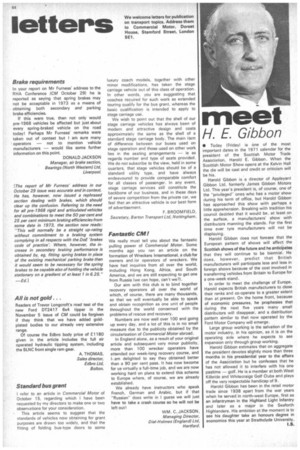Brake requirements
Page 66

If you've noticed an error in this article please click here to report it so we can fix it.
In your report on Mr Furness' address to the RHA Conference (CM October 29) he is reported as saying that spring brakes may not be acceptable in 1973 as a means of obtaining both secondary and parking brake efficiencies.
If this were true, then not only would pre-1968 vehicles be affected but just about every spring-braked vehicle on the road today! Perhaps Mr Furness' remarks were taken out of context but I am sure many operators — not to mention vehicle manufacturers -would like some further information on this point.
DONALD JACKSON Manager, air brake section, Bearings (North Western) Ltd, Liverpool.
The report of Mr Furness' address in our October 29 issue was accurate and in context. He has, however, now issued a rephrased section dealing with brakes, which should clear up the confusion. Referring to the need for all pre-1968 rigid and articulated vehicles and combinations to meet the 50 per cent and 25 per cent minimum braking efficiencies from some date in 1973, the section now reads: "This will normally be a straight up-rating without commitment to a braking system complying in all respects with the DoE 'brakes code of practice'. Where, however, the increase in secondary braking performance is obtained by, eg, fitting spring brakes in place of the existing mechanical parking brake then it would seem to be necessary for the spring brakes to be capable also of holding the vehicle stationary on a gradient of at least 1 in 6.25." —Ed.










































































































































































































